![]() The newcomer in the Yoctopuce circuit family is the tiniest of all, and yet you could find it greatly useful. At first sight, the Mini-Battery-Supervisor looks like a simple USB connector that you can mount on a front panel, but it contains regulation and control electronics for an external power source. Let's see what it can do....
The newcomer in the Yoctopuce circuit family is the tiniest of all, and yet you could find it greatly useful. At first sight, the Mini-Battery-Supervisor looks like a simple USB connector that you can mount on a front panel, but it contains regulation and control electronics for an external power source. Let's see what it can do....
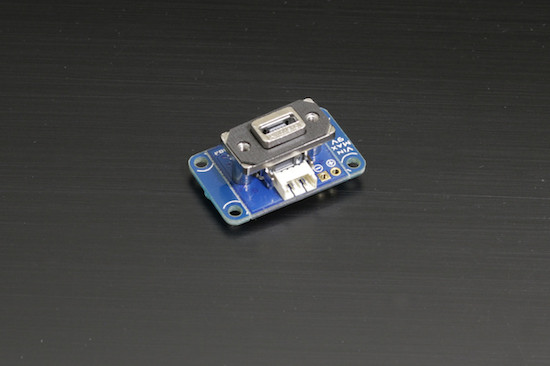
The Mini-Battery-Supervisor
When you build an autonomous measuring system, for example based on a YoctoHub-Wireless-g or a YoctoHub-GSM-3G-EU, you are necessarily confronted at one time or another with the question of the power supply of the system. The requested standard being a USB-type power supply, that is a 5V nominal voltage, you can use a USB battery. But this raises several problems.
Sharing the USB connector
When you power a system through the USB connector, this connector is not available anymore to connect a USB cable to configure the system. You can naturally disconnect and reconnect the other cable, but this forces you to power off the system, which is not necessarily what you want, for example if you want to retrieve data to debug a problem before powering off. Moreover, if the whole system is in an enclosure, you can't have the connector both accessible from outside the enclosure and connected to an internal battery at the same time.
The Mini-Battery-Supervisor provides an elegant solution to this issue. Equipped with a Micro-B USB connector which you can mount on a front panel and with distinct pads for an external power supply, it allows you to use both power sources at will, without however wiring them in parallel: an electronic switch toggles the power source depending on the presence or absence of a host on the external USB socket, without power drop during when switching from one source to the other.
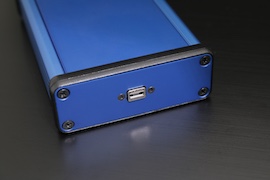
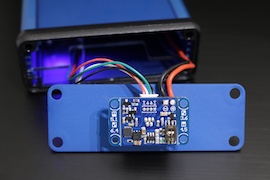
Fixing the Mini-Battery-Supervisor on a front panel
Voltage regulator
When the system must be powered by a battery, you can't power a USB device directly with NiMH or lithium batteries, because a too high voltage would damage the equipment. The recommended solution until now was to use one of these USB batteries for smart phones, which provides 5V precisely. But the problem with these batteries is that they have a tendency to automatically switch off when the system doesn't consume "enough", which makes them unusable for systems with very low consumption. Moreover, most of them are based on lithium cells, which prevents their use in fire sensitive applications, such as air transport.
The Mini-Battery-Supervisor provides a simple solution to use common NiMH batteries, as it includes a regulator lowering the provided voltage on the battery input to the 5V allowed by the USB standard. Note that it is a simple linear regulator, which is particularly suited for applications with low consumption. You can find more details in the product documentation.
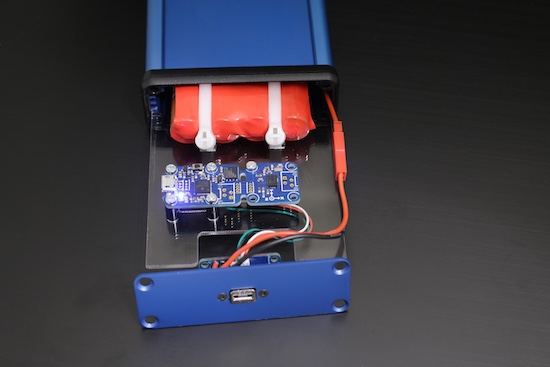
Using alkaline batteries to power a system by USB
Disconnecting when the batteries are flat
If you leave a device connected to batteries powered on indefinitely, the batteries will end up completely empty, which can raise two very serious issues:
- When an electronic system is used below a minimal voltage, there is a "brown-out" effect, which causes unpredictable and erratic behaviors. The processors can execute instructions partially, or randomly. And on top of all, this tends to corrupt flash memories, even when they are in principle write protected. It's therefore an effect that you must avoid at all costs.
- When batteries are emptied beyond the planned limit, their internal chemical structure modifies itself because of unwanted chemical reactions. Thus, a too flat lithium battery has a non-negligible risk of igniting when recharged, while a NiMH battery can switch polarity.
The Mini-Battery-Supervisor protects both the battery and the connected device against these issues thanks to the use of a voltage supervisor: the battery voltage is permanently compared to a pre-configured threshold, and as soon as it goes below the threshold, the device is powered off. To limit to the minimum the "brown-out" risk, the voltage at the device terminal is even actively drawn to 0V.
The device is powered on again only when the battery has been replaced by a charged battery: the reactivation threshold is much higher that the disconnection threshold. If it were not the case, the device would spontaneously reactivate in a loop, as voltage on batteries without load naturally goes up, and this again would create a "brown-out" risk.
Here is an example of an actual discharge curve. The red line corresponds to the voltage on the battery (5 NiMH cells of size AAA), while the blue line corresponds to the voltage measured directly on the device, protected by the Mini-Battery-Supervisor. The device is connected to a YoctoHub-Wireless-SR with two Yoctopuce sensors, configured to wake up every 10 minutes and to go back to sleep after 2 minutes.
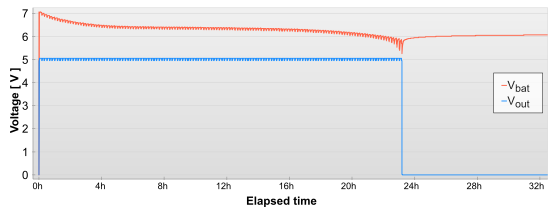
Discharge curve and power cut off
You can easily see the great difference between the battery voltage depending on the presence or absence of a load, when the YoctoHub goes into deep sleep, as well as when it is permanently powered off when the battery is depleted.
Disconnection and reactivation thresholds must be chosen with care because there isn't much difference between a full NiMH battery (1.3V) and the same but empty battery without load (about 1.25V). The Mini-Battery-Supervisor allows you to configure these threshold with micro-switches, by selecting among four combinations.
| Battery type | Disconnection threshold | Reconnection threshold | Residual consumption |
|---|---|---|---|
| 2S LiPo | 6.45V | 8.05V | 95uA |
| 4C Alkalines 5C NiMH | 5.0V | 6.25V | 75uA |
| 4C NiMH | 4.5V | 5.2V | 78uA |
| 1S LiPo | 3.5V | 4.05V | 60uA |
The residual consumption corresponds to the leakage current which goes into the Mini-Battery-Supervisor when the system is powered off when the battery is low. It is low enough so as not to damage the battery, unless it stay in this state for weeks on end.
Conclusion
We designed this product because it filled a need that we frequently encountered in projects that we created based on Yoctopuce modules and for which we hadn't found any commercially available solution. We thus hope that it will make your life easier as well!


